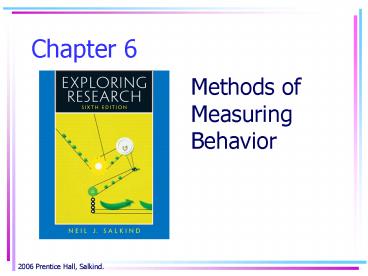Methods of Measuring Behavior - PowerPoint PPT Presentation
1 / 31
Title:
Methods of Measuring Behavior
Description:
upper half, wrong is in. lower half. 2006 Prentice Hall, Salkind. ATTITUDE TESTS ... The day before Thanksgiving should be a holiday. Final exams should be elective. ... – PowerPoint PPT presentation
Number of Views:320
Avg rating:3.0/5.0
Title: Methods of Measuring Behavior
1
Chapter 6
- Methods of Measuring Behavior
2006 Prentice Hall, Salkind.
2
CHAPTER OVERVIEW
- Tests and Their Development
- Types of Tests
- Observational Techniques
- Questionnaires
3
SOME IMPORTANT FIRST CONSIDERATIONS
- Is the tool you propose to use reliable and
valid? - Base your choice of research tools on how you
have asked the research question
4
TESTS AND THEIR DEVELOPMENT
- A test should measure the nature and extent of
individual differences - A good test differentiates people based on their
true scores
5
WHY USE TESTS?
- To help determine outcomes of experiments
- To diagnose strengths and weaknesses
- To assist in placing individuals in appropriate
programs - To assist in selecting applicants
- To evaluate a programs effectiveness
6
TYPES OF TESTS Overview
7
ACHIEVEMENT TEST SOURCES
- Standardized
- Commercially prepared for wide use
- Scoring instructions included
- Researcher-made
- Designed by user for specific purpose
- Scoring instructions specific to test
8
ACHIEVEMENT TESTS REFERENCING What Comparison Do
Tests Make?
- Norm-referencedIndividuals scores are compared
to results from a larger group - Criterion-referencedIndividuals scores are
compared to defined performance standards
9
MULTIPLE-CHOICE ACHIEVEMENT ITEMS Anatomy of a
Multiple-Choice Item
10
TO USE OR NOT TO USE?
- Advantages
- Versatile
- Easy to score
- Simple to take
- Poor writers not penalized
- Good items used again
- Good distracters are diagnostic
- Hard to fake correct answer
- Disadvantages
- Limit students options
- No opportunity to practice writing
- Some people dont do well on them
- Limits content to be assessed
- Items must be well written
11
ITEM ANALYSIS HOW TO TELL IF YOUR ITEMS WORK
- Questions should discriminate those who know the
material from those who dont - Item analysis provides two measures of a
questions ability to discriminate - Difficulty index
- Discrimination index
12
COMPUTING INDICES First Steps
- Rank scores from highest to lowest
- Choose top 27 of scores for high group
- Choose bottom 27 of scores for low group
13
COMPUTING INDICES
14
COMPUTING INDICES
- Difficulty index
- Proportion who answered item correctly
- D NCh NCl
- T
- Discrimination index
- Proportion in high group who answered correctly
minus proportion in low group who answered
correctly - D NCh - NCl
- (.5)T
15
RELATIONSHIP BETWEEN ITEM DISCRIMINATION AND
DIFFICULTY
Perfect Discrimination When ½ gets item
right, ½ gets item wrong
½ right is in upper half,
½ wrong is in lower half
16
ATTITUDE TESTS Assess an Individuals Feelings
About a Topic
17
THURSTONE SCALES Method of Equal Appearing
Intervals
- Statements indicating an attitude toward a topic
are written - Judges rank the statements from least favorable
to most favorable - Statements receiving consistent ratings are given
the average score - A set of statements is selected that covers the
entire range of attitudes
18
THURSTONE SCALES Administration
- Respondents check items with which they agree
- Well-formed attitudes are indicated by
consistently checking either high or low items - Poorly-formed or inconsistent attitudes are
indicated by inconsistent pattern or by checking
off many neutral items
19
LIKERT SCALES
- Statements indicating an attitude toward a topic
are written - Items with clearly positive or negative attitudes
are selected - Statements are listed with a space for respondent
to indicate degree of agreement
20
A LIKERT SCALE
21
SCORING LIKERT RESPONSES Method of Summated
Ratings
- Items are weighted
- Weights of unfavorable items are reversed
- Average score is computed
22
PERSONALITY TESTS
- Projective tests
- Present respondent with ambiguous stimulus
- Structured tests
- Questions are objective
23
OBSERVATIONAL TECHNIQUES
- Researcher observes and records
- Does not interfere with behavior
24
TECHNIQUES FOR RECORDING BEHAVIOR
25
OBSERVATIONAL TECHNIQUES? BE CAREFUL! Pitfalls
to Avoid
- Observer effects
- Observer bias
- Fatigue
- Changing definitions
26
QUESTIONNAIRES
- What they are
- Paper and pencil tests with structured questions
- Self-administered
27
QUESTIONNAIRES
- Advantages
- Can be mailed out
- Survey broad geographic area
- Cheaper than one-on-one interview
- Respondents may be more honest
- Data easy to share with other researchers
- Disadvantage
- Low return rate
28
BASIC ASSUMPTIONS OF A QUESTIONNAIRE
- Does not make unreasonable demands upon the
respondent - Does not have a hidden purpose
- Requests information that respondents presumably
have - Contains interesting questions
- Does not request information that could be
obtained by other means
29
THE QUESTIONS
- The questionnaire contains questions that can be
answered - The questionnaire contains questions that are
straightforward
30
THE FORMAT
- The presentation is attractive, professional, and
easy-to-understand - Questions and pages are clearly numbered
- Directions are clear and explicit
- Questions are objective
- Questions are ordered sensibly
- Transitions are used from one topic to the next
31
THE IMPORTANCE OF USING A COVER LETTER
- Informs the recipient about the research
- Establishes the importance of the research
- Makes the recipient a part of the research































